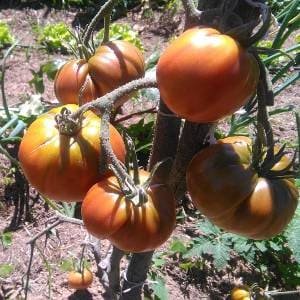7 essential care of the tomato plant
Warning: Undefined variable $ad_top in /home/u376105422/domains/mundohuerto.com/public_html/main-html-en.php on line 91
Warning: Undefined variable $ad_article in /home/u376105422/domains/mundohuerto.com/public_html/main-html-en.php on line 124
Warning: Undefined variable $ad_article in /home/u376105422/domains/mundohuerto.com/public_html/main-html-en.php on line 130
Warning: Undefined variable $ad_into_article in /home/u376105422/domains/mundohuerto.com/public_html/main-html-en.php on line 153
Warning: Undefined variable $ad_into_article_full in /home/u376105422/domains/mundohuerto.com/public_html/main-html-en.php on line 154
Warning: Undefined variable $ad_inter_item in /home/u376105422/domains/mundohuerto.com/public_html/main-html-en.php on line 155
Tomato cultivation presents some variations depending on whether it is carried out outdoors, in a greenhouse or in a pot. In the first two, the care is practically identical, with the exception of the tutoring.

We begin this article starting from the moment of transplanting the tomato, since the realization of the seedbed is a previous task with care common to most vegetables.
We will explain irrigation, mulching, weed control, pruning, hilling, trenching, and pest and disease prevention.
Irrigation
Once the transplant is done, the first care that we will take into account is irrigation. The young tomato plant is taking root and must find the moist soil as its roots explore it.
Fertilization
Tomatoes are very voracious plants, which consume large amounts of nutrients throughout their cycle, and for this reason it is very important to maintain high soil fertility.
Mulching
Once the plants are about 20 cm high, we can proceed to mulch with organic materials such as straw, dry grass, compost, etc.
It can be mulched before transplanting, but it is better to wait for the soil to warm up a bit in the spring sun, since when covering the soil it warms up more slowly, unless it is covered with compost —because of its black color.
If the mulch is plastic, it is better to install it before transplanting to avoid damaging the plants when it is being handled, or even when it is being watched.
In organic mulches, it is important that they are dry so that the materials do not ferment once placed in place, since they can be a source of diseases.
Weed control
It consists of removing by hand —or with a tool— the spontaneous herbs that are germinating between the tomato plants. It is best to do this in dry, sunny weather so that the top layer of soil is loose and seeds that have not germinated will not germinate until it rains.
This care can be eliminated almost completely if we make a good padding.
Pruning
15 or 20 days after the transplant, we will have to start pruning the axillary shoots that will begin to appear on the tomato plants —depending on the variety or varieties we have planted— since in some it is not necessary.
Ridged
Once the lower leaves of the tomato plants have been pruned, we will perform the hilling, which consists of bringing the soil closer to the stem —making a spine or ridge— to cover a few centimeters of it and make it easier for it to emit new roots in that area and improve the capacity plant absorption.
We can do it with soil or by adding compost, but be that as it may, we must be careful not to cause wounds on the stem through which pathogens can enter.
Staked
It consists of having some structure to guide the growth of the plant. Traditionally it has been made with reeds or sticks stuck into the ground and to which the stem of the tomato plants was tied.
In professional crops, complex systems of posts linked by wires and mobile hangers on which the stem is attached are used.
In a family garden, the most practical thing is to use sticks or iron rods -they last much longer- and place one for each plant.
In our orchard we use a mixed system since we nail thick wooden posts — about 2 or 2.5 meters high — every 2 or 3 meters and join them at the top with another wooden crossbar, as if we were making a soccer goal. Then, with a wire about 2 or 3 mm thick -anything will do but be smooth, rigid and strong- we cut a fragment for each tomato plant, approximately 50 cm longer than the height from the crossbar to the ground. We bend the wire at one end to make a hanger that is attached to the crossbar and we stick the other end into the ground, near the foot of the tomato plant.
With this system, once we have the wires in place, we will only have to rotate the tomato plant around it —as it grows—, as if it were a vine.
Prevention and control of pests and diseases
If we're lucky—or very good, and often both—we may only need a few preventative treatments to keep the fungus from infecting the tomato plants.
Fungal diseases are usually the most frequent enemy of tomato cultivation and, if we do not do good prevention, they appear so quickly that sometimes there is no time to react, and they infect the entire plantation in a short time. At that point, little can be done without resorting to systemic chemical fungicides.
Preventive care goes through:
- Guarantee good aeration of the crop, respecting the planting framework and pruning excess vegetation.
- Do not cause large wounds or tears in the tomato plants and do pruning and cutting with low humidity (in the afternoon on sunny days).
- Remove the old, sick or broken parts and take them away from the crop or burn them.
- Carry out preventive treatments with ecological fungicides.
- If possible, prevent rain from falling on the tomato plants by covering them with a plastic structure.
- Avoid wetting the tomato plants when watering.
For pests, good prevention begins with crop rotation and association, but we will talk about it in a specific article dedicated to tomato pests.